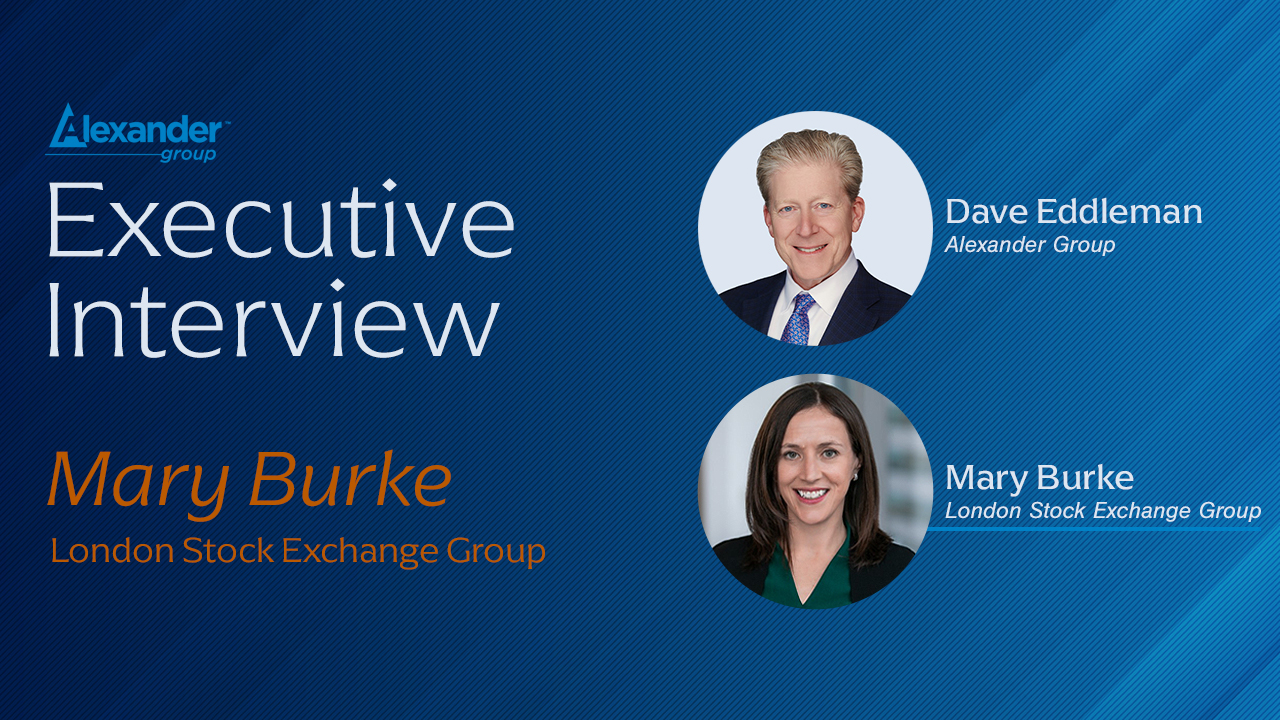Jeff Wood: Hi. Today we have the pleasure of speaking with a long-standing fintech and technology leader who has seen many financial services transformations over the years. I’m Jeff Wood. We have the pleasure of speaking with Bill Zielke today to talk about the major challenges facing today’s technology and fintech companies. Bill, welcome. We’re glad to have you here. Would you give our audience a little bit of an overview of your background as a revenue growth leader? And then we’ll talk a little bit about the challenges that you’ve seen over the years.
Bill Zielke: Jeff, first of all, thank you for having me. Appreciate the Alexander Group’s opportunity to join you today. As Jeff mentioned, I’m Bill Zielke. I’ve looked after financial services and fintech for more than 30 years in my career, some with some large enterprises like fortune 500 companies like PayPal or Fiserv, as well as some emerging companies more in the early technology. You might even say some venture backed in the startup space. Most of my roles have really been looking after the revenue line as well as the marketing activities, the whole go to market strategy. Some of the brands, like Checkfree, we were going to market in more of a B2B fashion and looking at how do we acquire companies. So, the sales team and the model that we had there was certainly important to what really, we were focused on. Other companies like PayPal were really trying to take new products into new markets. Um, so I had the opportunity to really see that type of opportunity and as part of my background and then here more recently in the last probably 4 or 5 years, a variety of different startups, more venture-backed, Silicon Valley-type funded companies that are really literally introducing or launching disruptive products into brand new markets. So, we’re launching people, we’re launching technology – all to create revenue lines.
Jeff Wood: Great. That’s amazing. Bill, you’ve seen a lot of disruption over the years. You’ve seen a lot of things work; a lot of things not work right at different companies. Have they’ve gone through evolution and change? Today, if revenue leaders fail to get it right, they could have problems with low revenue growth. They could have conflict between their internal teams and then they could also have a very poor customer experience. When you think about some of the top two things that revenue leaders have to deal with to be successful through all these changes, one of the things we’ve talked about is getting the coverage model right. I’d love to get your perspective, Bill, as you’ve seen a lot of different types of companies, how do you think about single account owners and bifurcated owners where you have separate hunters and farmers in the model?
Bill Zielke: Yeah, you’re right, Jeff, I’ve definitely seen it all – from early-stage companies who will launch one model or enterprises who perhaps need another. You know, I think it’s a great question because I really think it depends. It depends on the circumstances of the company and really what they’re trying to accomplish. For example, in one emerging company, we’re introducing a product to displace an existing set of products. The way you go about that is you’re talking to the same people who are doing something one way, and you’re trying to convince them to do another. You need a specialist. So, a coverage model that has a dedicated hunter made a lot of sense there. And other models, we had high market penetration. Maybe really trying to squeeze it out for that last 10-15% market share, before we had the entire market swept, we needed an entirely different type of coverage model and more of a blended type of role so that we could focus on renewals and scaling. So, I think it really depends. I think the smartest thing that most companies can do is try to step back and say, what am I trying to accomplish? Where am I in the journey of launching this product and penetrating the market and making a hard assessment of what those metrics and those goals are? So, I really think it depends in terms of how you calibrate that model to the specific needs of the company.
Jeff Wood: And it’s probably not always just the needs of an individual company. Those needs may change over time. So, you may be with a given company, but as they introduce new products or value-added services that they need to cross-sell, you might have different selling needs as their portfolio expands or they need to worry about renewals, cross-sell, upsell, adoption. It may take different skill sets, as they evolve. Do you have any thoughts around how you’ve seen that work or how frequently do you need to think about changing the model?
Bill Zielke: You know, Jeff, I think you mentioned an important word change. Change is inevitable, right? And you have to prepare for the change. And I think when a company has a product change or a market condition that’s changed, we’ve certainly seen that over the last few years. They’ve got to step back and reassess. They’ve got to first decide what’s important, what’s the priority? Is it revenue growth? Is it expanding the team so that they can acquire more businesses? And that’s really going to dictate the change, and it will shift the coverage model. It might shift the employee mix and the skill sets that you have. And it might even also shift where the company’s emphasis is overall in terms of is it more important for me to focus on renewals and expanding what I already have versus trying to acquire new relationships? At least in the industries that I’ve had exposure to, many of them have been largely focused on acquiring new entities. You grow by acquiring more new customers and that’s, you know, part and parcel to being in more of the fintech space and needing new relationships and launching new products. But even within that, over the years we’ve had to adapt the coverage model that we put in place. Just because our priorities might have changed, we may have launched a new product, and now that product is more profitable. So, you shift your coverage model or tweak it. And again, I think doing those assessments periodically, maybe it’s year to year, gives the organization the insight to say what changes are necessary. The one thought I would have is that they can’t be afraid of that change. They’ve got to look at it every year, and they’ve got to be able to focus on, you know, putting that in place in a timely manner, despite maybe how disruptive it might be.
Jeff Wood: And the change can be very difficult to navigate in some cases. You mentioned skill sets. You may need different skill sets. Maybe some people don’t want to do some of the roles if you have to make that change, right? So, you have to find a way to adapt and evolve to get the right mix. And we’ve seen some companies, if they wait too long for change or they wait for the change to be forced upon them, it’s often a very difficult outcome, very difficult to navigate. How do you think about seeing that change ahead of time? When is the right time and how do you think about beating the need when it actually comes down to getting ahead of the curve?
Bill Zielke: I would say listening to your, your marketplace, listening to your customers and then looking at the data. I mean, the data is king. If you’re penetration is expanding at the rate you want, if the competition is perhaps winning deals over and above you, you might have a symptom in your model that you either have a skill set issue, or you perhaps might not be rewarding the right behaviors that you want the sales team or the account management team to be pursuing. So, I think how you know, is just by continuing to study that data, continuing to listen and in a lot of cases listening to your reps. They’ll tell you, hey, I’m struggling to hit this goal, but these other goals are a lot easier. Or maybe the company ought to tweak the model a little bit to give me more runway or give me more ramp in this other area. So, I think listening to some of those needs can be a great leading indicator as well, but the data rules – you’ve got to kind of keep up with some of those key metrics.
Jeff Wood: That’s a great call out, Bill. Listening from the field and getting that voice of customer for how people are reacting to your value prop, the selling motions, the value prop that the sellers need, right. That can really be a driver of helping you decide when you need to change because your buyers are starting to change. You know, you hit on one of the things that once you get the coverage model right, you really got to make sure you’re driving the right behaviors. You want to make sure you’re motivating the team. And as those roles change, the primary responsibility of the role may change, the rules of engagement may change, and you certainly need to change the comp plan to motivate folks. What types of challenges or things have you seen over the years for how to think about some of the compensation plan changes as you change your coverage model?
Bill Zielke: Yeah, it’s a great question. I’d always say focusing on the sales operations piece. I always say your plan is only as good as your greatest rep, because they’re always going to find holes in the plan. Whether it’s a hole that they can exploit or in other cases whether it’s a hole that really just is trying to align with what the company is trying to do. So I think how you line those things up is when you first decide what’s important. And the enterprise acquisition businesses that I’ve been exposed to signing that deal, getting that logo is often identified as the top priority. But when you start to peel that back, you figure out, well, it’s not just acquiring them with a contract. Maybe there’s an integration that’s required or a setup in a marketing set of activities that that client then needs to do, and getting those sub metrics equally identified and captured as part of the plan components can be critical often to the company’s success. A new relationship is no good if they just sign a contract and never do anything with it, so you’ve got to reward them along the way in order to get the right behavior. You’ve also got to decide who’s going to do that. Is the sales rep going to just sign the contract and hand it off, or are they going to stay with it until the contract’s been implemented in the accounts live? Those are the different types of things that I think the company has to think through. And again, having that process or a process to look at those and figure out where the value is, will determine whether the sales team is going to be successful or not.
Jeff Wood: You also talked about the evolution of where somebody is in their lifecycle, their products that they have, how early they are in that stage. You know, one of the things we often see is, you know, you go sign the logo, you need to really land in the market and get your footprint. But then over time, the time period may vary by company. It really becomes, well, when is the revenue going to come? When do we hold people accountable for the actual results? And there’s a number of complications with that. Maybe implementation time. It could be, do you want your hunter sticking around to try to drive adoption? You know, how have you seen that play out over time? And are there certain tactics that you’ve thought about given your specific situations you’ve seen that you’ve used or have seen work?
Bill Zielke: I love this question because, I mean, I’m living it right now in my current role, as chief revenue officer over at BitPay, where volume is king for us. You can’t just acquire a logo and not see the volume come out the other side, because our revenue model is dependent upon that volume. And so having someone stay with that process, um, initially we said, hey, it’s just going to be the sales rep. And what we’ve learned is, well, that takes time away from them continuing to sell in the field. So now we need an account manager, a separate role. And over the years, my experience has been having two different roles has proven to be more effective when you’re more volume based, because that’s our key metric. You’ve got to look at what’s most optimal for the organization. It’s the organization has needs. They have cost targets that they need to hit. So maybe that model doesn’t always fit. So, I think again, it kind of comes back to it depends. But what we’re living right now is having that bifurcated model tends to make the most sense for us. Because you have somebody sign, help implement, then you still have somebody that stays with the account that helps them scale. And so that’s just part of, you know, what that process needs to look like.
Jeff Wood: And as you described, you’ve got to drive the revenue eventually. Right. And that you’re accountable for that. But you also want to make sure that you’re paying at the point of influence for sales and rewarding them for some long sales cycles, potentially. That’s right. So, you know, sometimes there may be splitting up and paying some up front and then paying the rest on the back end. Right. There’s a lot of different levers that you have to think about. But the situation is always different. And you have to think about what’s right for that point in time for your company. Yeah.
Bill Zielke: Couldn’t agree more. We’ve even shifted that percentage of that payout um, further back in the process to get a little more volume emphasis. Because sometimes if you get it too far forward, you get the contract, you get the integration, you may not ever get the volume, and you really haven’t accomplished what the organization really needs to do. So, getting that balance right may evolve year to year. It may be one of the things are the KPIs, if you will, that you’re changing. But I think it’s important that you go through that process to assess what that emphasis should be, because you’re right and that rep does need to get rewarded. Our average sales cycle is 6 to 9 months. The rep puts in a lot of time and a lot of effort. The marketing team puts in a lot of time and effort to help acquire those relationships. So you want to just make sure that you optimize exactly how fast you get them through the funnel, and how quickly that volume can follow.
Jeff Wood: Great, Bill. Thank you so much. Great advice from multiple companies that you’ve seen over the years. You know, some parting words as we think about, you know, any guidance you have for CROs and CMOs that may be facing some of these challenges across coverage and compensation? You know, two of the primary challenges they have to address, or if they don’t get it right, they run into some of the issues we talked about earlier. Do you have any parting words for the audience of, you know, things that they should be thinking about to better navigate change?
Bill Zielke: I guess my parting words would be don’t be afraid of change. Go through the exercise to really assess what’s important and change it. I know that could be a frightening thing because sales don’t like change, right? You’re often perhaps putting or at least believe that you’re putting some of your top producers at risk. But they want to change too. They want to evolve too, and they certainly want the opportunity to earn more. So, by introducing some of these changes, you find out how to optimize the sales reps’ needs with the organization’s needs. And that doesn’t have to wait. A lot of times I think you launch a plan, or you launch an activity or a go-to-market model, and because it took so much energy and it took so much effort, it’s almost like a glass house and you’re afraid to tweak it. But I’d say, don’t be afraid to do that. Change is good, I think, in this regard, because you can really find that healthy balance.
Jeff Wood: Great, Bill, great words of wisdom. Thank you so much for your time and your experience and sharing that with everybody. We look forward to seeing more success from you over the years. So thank you so much.
Bill Zielke: Thanks, Jeff. I appreciate you having me. Thank you.





